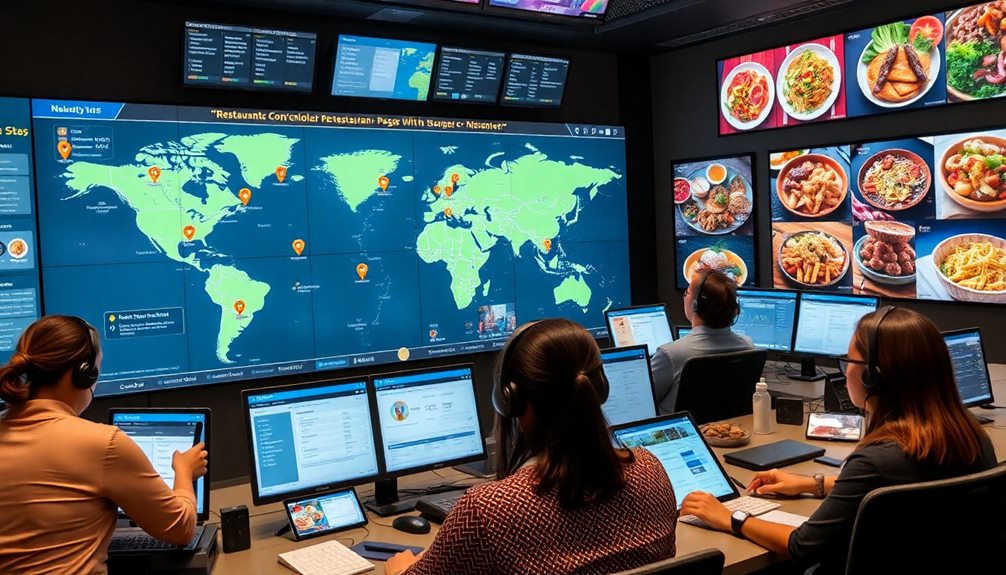Managing multiple restaurant locations starts with establishing a solid management structure. You'll need to implement standardized procedures to guarantee a consistent experience across venues. Use centralized management systems for real-time communication and tracking of performance metrics. Embrace technology to streamline workflows and automate tasks, reducing your workload. Regularly monitor key performance indicators to identify areas for improvement and make informed decisions. Effective delegation to skilled managers will allow you to focus on growth. With these strategies in place, you'll create a more efficient operation, enhancing customer satisfaction and profitability. Discover further insights to elevate your multi-unit management approach.
Key Takeaways
- Implement a centralized management system to streamline operations, ensuring consistent quality and efficiency across all locations.
- Utilize cloud-based communication tools to facilitate real-time updates and collaboration among staff and management teams.
- Establish standardized operating procedures to create uniform customer experiences and maintain brand consistency across all sites.
- Monitor key performance indicators (KPIs) for each location to identify improvement areas and enhance overall performance.
- Delegate responsibilities to skilled managers at each location, allowing focus on strategic growth and operational excellence.
Key Areas of Focus

When you're managing multiple restaurant locations, it's important to zero in on key areas of focus to secure success. Structuring your management effectively is essential. It guarantees each unit operates cohesively under a unified strategy, which fosters a sense of collaboration among your teams.
Incorporating unique experiences, such as live music dining, can also enhance the appeal of each location and attract diverse crowds.
Streamlining operations across all locations will improve efficiency, leading to enhanced service speed and customer satisfaction. Consider implementing thorough restaurant management platforms that allow for greater visibility and communication. These tools can facilitate real-time updates and decision-making, keeping everyone on the same page.
Consistency is critical for building a strong brand identity. Standardized processes across locations help maintain the same level of service and food quality that your customers expect.
To achieve this, delegate responsibilities to capable managers at each site. This delegation empowers leaders to focus on strategic growth while making certain daily operations run smoothly.
Effective Management Strategies

Effective management strategies are essential for maneuvering the complexities of overseeing multiple restaurant locations. To maintain consistency and quality service, you should focus on these key areas:
- Standardize Operating Procedures: Confirm that all locations follow the same procedures. This creates a uniform experience for customers, making them feel at home no matter which restaurant they visit.
- Delegate Responsibilities: Empower skilled managers at each location to take charge of day-to-day operations. This allows you to concentrate on strategic growth and long-term goals rather than getting lost in daily tasks.
- Implement a Centralized Management System: Streamline your accounting, scheduling, and training processes. A centralized system enhances efficiency and provides better visibility into performance expectations across all locations.
Utilizing cloud-based communication tools can also foster collaboration among your teams, enabling them to share best practices and insights.
Regularly monitoring key performance indicators (KPIs) and conducting financial assessments across your restaurants will help you identify areas for improvement and confirm that each location contributes to the overarching success of your brand.
Importance of Visibility
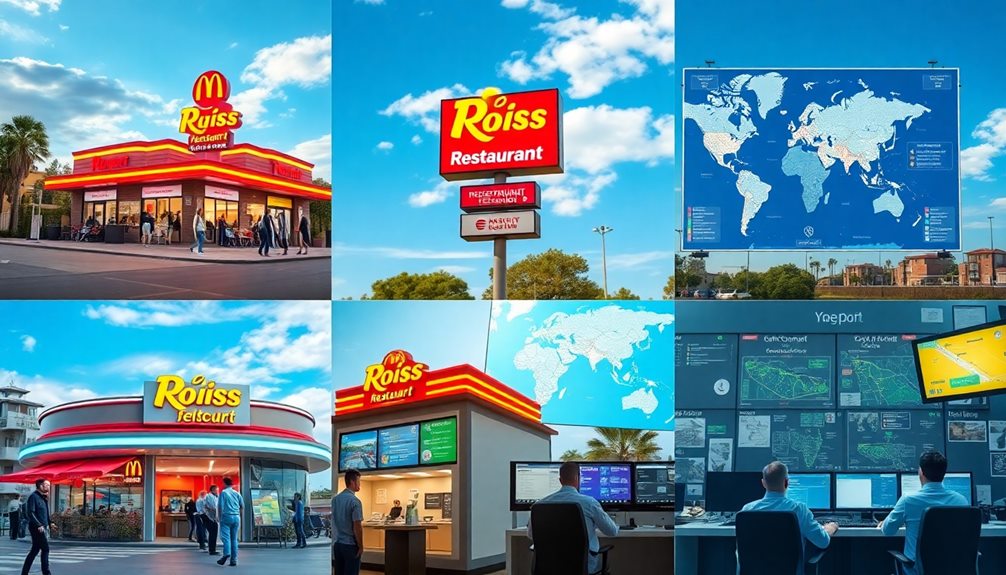
Visibility into performance metrics is essential for successfully managing multiple restaurant locations, as it empowers you to make informed decisions that enhance operational efficiency and guarantee a consistent guest experience. By utilizing a centralized platform, you can track key performance indicators (KPIs) in real time, allowing you to identify trends and areas for improvement swiftly. This visibility helps you allocate resources effectively, assuring that each location meets its goals.
| Metric | Importance | How to Improve |
|---|---|---|
| Sales Performance | Reflects overall revenue | Analyze peak hours |
| Inventory Levels | Prevents stock shortages | Implement regular audits |
| Employee Performance | Influences service quality | Provide ongoing training |
| Financial Health | Ensures sustainable growth | Regularly review reports |
Moreover, by sharing best practices and insights among managers, you cultivate a culture of continuous improvement that boosts operational effectiveness across all locations. Maintaining visibility into financial health through centralized reporting mitigates risks and supports growth. With the right tools and focus on visibility, you can steer your restaurant group towards long-term success.
Centralized Management Systems
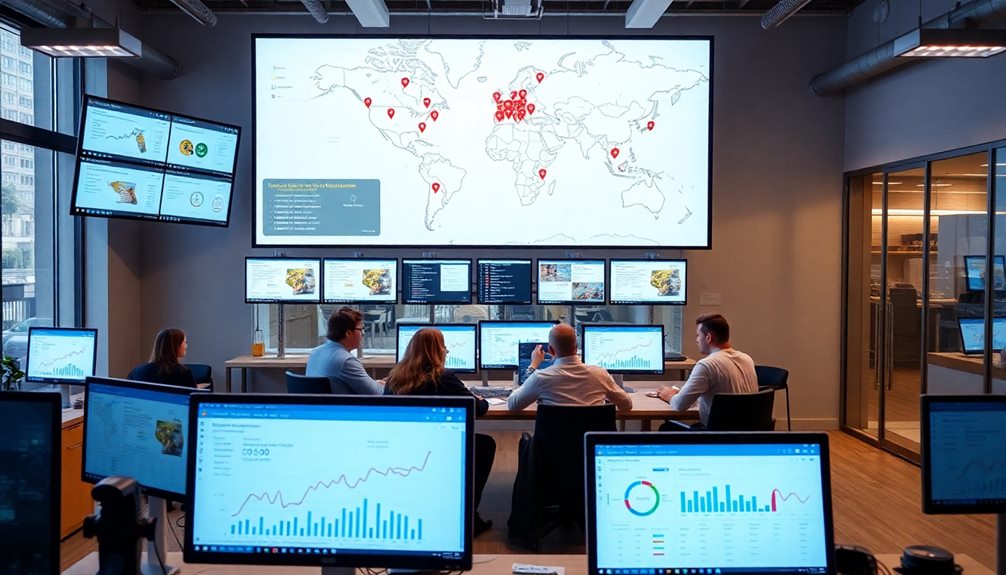
Centralized management systems can transform how you operate multiple restaurant locations by streamlining workflows and simplifying financial tracking.
With enhanced performance visibility, you'll quickly spot areas for improvement and make informed decisions.
This integration not only eases your administrative load but also helps maintain consistency across your brand.
Streamlined Operational Workflow
Streamlining operational workflows across multiple restaurant locations hinges on the implementation of a centralized management system. This approach integrates various functions such as accounting, scheduling, and training, leading to improved operational efficiency.
By centralizing disparate systems, you can standardize procedures across all locations, ensuring consistency and quality. Additionally, effective payment strategies can enhance transaction processing, which is critical for maintaining a smooth operational flow.
Here are three key benefits of a centralized management system:
- Enhanced Data Management Capabilities: Centralization allows for better organization and analysis of data, providing you with valuable insights for decision-making.
- Improved Communication: Cloud-based platforms facilitate real-time communication and visibility into performance metrics, enabling managers to stay informed across locations.
- Effective Delegation: With streamlined operational procedures, you can delegate responsibilities more efficiently, allowing your leadership team to focus on strategic growth while maintaining oversight of daily operations.
Enhanced Performance Visibility
Effective performance tracking is vital for managing multiple restaurant locations successfully. By implementing centralized management systems, you streamline operations and gain access to real-time data that can enhance decision-making. These systems integrate accounting, scheduling, and training, guaranteeing that your operational procedures are standardized across all locations, which is essential for maintaining brand identity.
With cloud-based solutions, you can monitor key performance metrics effortlessly. This visibility not only helps in identifying areas for improvement but also fosters accountability among your teams. You can simplify delegation of responsibilities and focus on strategic growth while guaranteeing consistency in service quality.
Here's a quick comparison of centralized management system benefits:
| Benefit | Description |
|---|---|
| Real-time Data | Access up-to-date performance metrics across locations |
| Streamlined Operations | Integrate various functions into one platform |
| Standardized Procedures | Guarantee consistency in service quality |
| Enhanced Communication | Foster collaboration among distributed teams |
| Focus on Growth | Allow management to prioritize strategic initiatives |
Simplified Financial Tracking
Managing your restaurant's finances across multiple locations can feel overwhelming, but a centralized management system simplifies the process. By integrating financial tracking across all your units, you gain real-time visibility into sales, expenses, and profitability metrics. This clarity lets you make informed decisions that drive your business forward, especially when you understand key financial terms such as budgeting essentials.
Here are three key benefits of using centralized management systems:
- Streamlined Processes: Cloud-based accounting software automates invoicing, payroll, and budgeting, cutting down on errors and saving you time.
- Standardized Reporting: With uniform financial reporting templates, comparing performance metrics across locations is easier, allowing for quick assessments of what's working and what isn't.
- Automated Insights: Centralized systems enable automated financial assessments and forecasting, helping you identify trends and adjust proactively to enhance profitability.
Financial Considerations

When you're considering opening a new restaurant location, you'll need to think about the capital investment required and how to obtain that funding.
Options like equipment loans and lines of credit can help, but it's vital to assess the financial health of each location before making a commitment.
Regular financial evaluations will keep you on track to guarantee profitability across your entire restaurant group.
Capital Investment Requirements
Maneuvering the financial landscape of opening multiple restaurant locations requires careful planning and substantial capital investment. Typically, you're looking at costs exceeding $500,000, influenced by factors like location, concept, and size.
To get a clear picture of your capital investment requirements, focus on these key areas:
- Building Leases and Renovations: Secure a location and budget for any necessary renovations.
- Equipment Purchases: Invest in kitchen appliances, furniture, and décor to create the desired atmosphere.
- Initial Inventory: Stock up on food, beverages, and supplies to get your location off the ground.
Having a detailed business plan is essential for evaluating your expansion's feasibility. This plan should outline projected expenses, revenue, and funding sources.
Regular financial assessments will help you manage operational costs effectively, ensuring each location remains profitable and financially sustainable. Understanding your funding options will be vital for accessing the necessary capital for growth, so be prepared to explore loans and credit lines that suit your needs.
Funding Options Available
Securing adequate funding is vital for expanding your restaurant empire, and a variety of options are available to help you navigate this financial landscape. When you're looking at restaurant expansion, consider capital loans designed specifically for your industry. Options like equipment loans, working capital loans, and lines of credit can provide the necessary funds to cover building expenses, equipment purchases, and employee salaries.
Entities such as Toast Capital offer loans ranging from $5K to $300K, tailored for restaurant needs. These loans typically feature fixed costs and automated repayments based on your sales, giving you the flexibility to manage your cash flow effectively.
You'll want to assess the repayment terms, which can vary from 90 to 360 days based on your eligibility. Before making any decisions, consulting a financial professional can help you understand your funding options and guarantee you're choosing the best path for your expansion plans.
Financial Health Assessment
Your restaurant's financial health is the backbone of successful expansion across multiple locations. Regular financial evaluations are essential to manage operational costs effectively and guarantee each location remains profitable.
Here are three key areas to focus on during your financial health evaluation:
- Track Expenses and Revenues: Monitor each establishment's financial performance individually. This will help you identify profitable areas and those needing improvement.
- Evaluate Financial Projections: Create a thorough business plan that includes detailed financial projections. This will guide you in evaluating the feasibility of opening new locations while sustaining existing ones.
- Examine Financial Health Indicators: Keep an eye on sales figures and debt levels. Consistent sales and manageable debt are critical indicators that determine your readiness for expansion in the competitive restaurant industry.
Communication and Organization
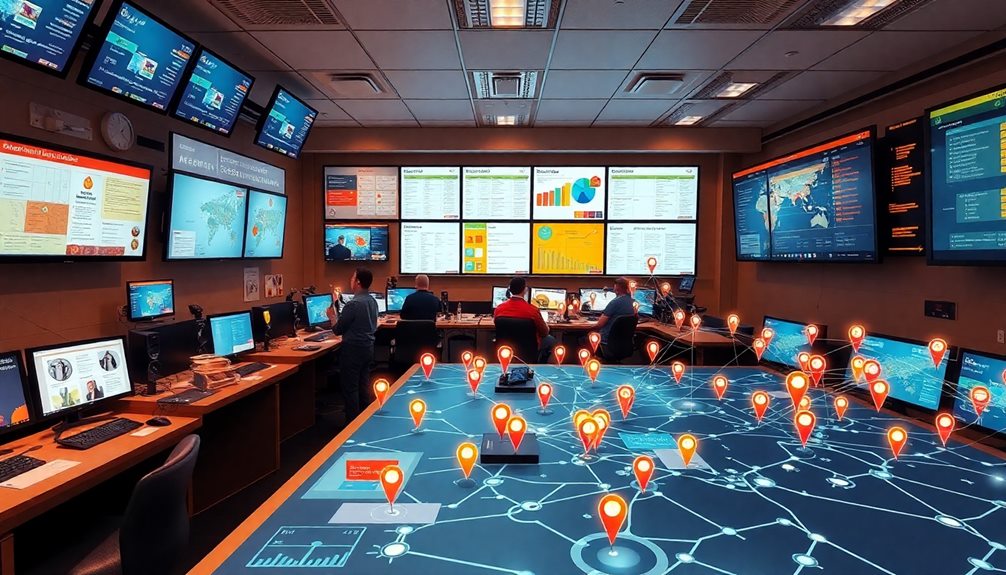
Effective communication and organization are essential for managing multiple restaurant locations successfully. Establishing open lines of communication among all team members promotes teamwork and clarity, ensuring everyone aligns with your restaurant's goals. Regular meetings, whether in-person or virtual, can encourage feedback and problem-solving, helping you address issues across locations effectively.
Utilizing communication tools like digital messaging platforms allows for quick updates and announcements, ensuring important information reaches everyone promptly. This is important for maintaining a cohesive team and enhancing operational efficiency. Set clear expectations for employee performance and responsibilities to foster accountability across your management system. This clarity helps everyone understand their roles and reduces misunderstandings.
Furthermore, implementing automated inventory systems is critical for managing stock levels across multiple locations. It reduces discrepancies and streamlines your ordering processes, allowing you to focus on leading your team and enhancing the customer experience.
When communication and organization are prioritized, you'll create a well-oiled operation that can adapt and thrive, regardless of the challenges that come with managing multiple restaurants. By doing so, you'll not only improve efficiency but also foster a strong team culture that drives success.
Technology Integration and Growth
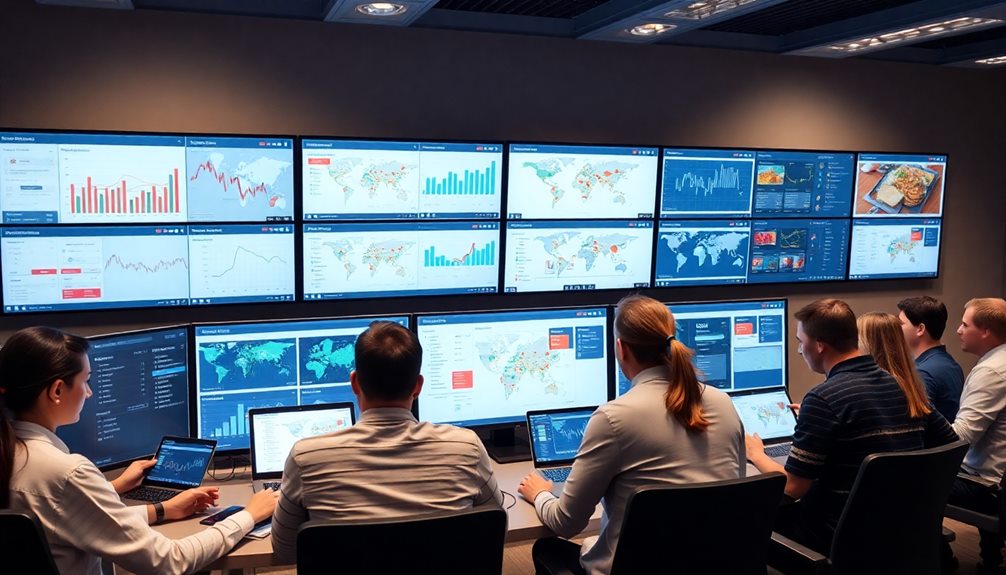
Building on the strong foundation of communication and organization, integrating technology into your restaurant operations can greatly amplify growth across multiple locations.
By leveraging technology integration, you can enhance operational efficiency and streamline processes in your multi-unit restaurants. Here are three key areas to focus on:
- Cloud-Based Management Systems: Implementing these systems centralizes tasks like inventory management, scheduling, and sales tracking, making it easier to oversee multiple locations from one dashboard.
- Delivery Optimization Tools: Utilize platforms like Grubhub for Restaurants to enhance delivery processes and keep your menu updated. This can boost customer satisfaction and drive revenue growth.
- Analytics Tools: Harness the power of data to track performance metrics. This allows you to make informed, data-driven decisions, improving operational insights and guest experiences.
With 95% of restaurant owners reporting improved efficiency through technology integration, it's clear that embracing these tools is crucial for modern multi-unit restaurant management.
Additionally, consider exploring virtual restaurants as a creative revenue stream, helping you reach new markets without the need for extra physical space.
Frequently Asked Questions
How to Manage Multiple Business Locations?
To manage multiple business locations, you need to establish a centralized system, implement standardized processes, delegate responsibilities effectively, and utilize cloud-based communication tools. Regular financial assessments will keep you informed and guarantee operational efficiency.
What Is It Called When a Restaurant Has Multiple Locations?
So, you think owning one restaurant's tough? Imagine juggling several! When a restaurant has multiple locations, it's called a multi-unit operation. You'll need a magic wand—or maybe just some solid management skills!
How Do Chefs Run Multiple Restaurants?
To run multiple restaurants, you standardize recipes, cross-train staff, and maintain effective communication. You utilize technology for inventory management and conduct regular training sessions to guarantee consistent quality and uphold your brand's culinary standards.
What Do You Call a Person Who Owns Multiple Restaurants?
You'd call a person who owns multiple restaurants a multi-unit operator or multi-unit franchisee. They manage several locations, leveraging their expertise to guarantee efficiency, consistency, and quality across their diverse culinary ventures.
Conclusion
Managing multiple restaurant locations can feel overwhelming, but with the right strategies, it's not only manageable—it can be rewarding. By focusing on visibility and employing centralized management systems, you can streamline operations and maintain quality. However, some believe that hands-on involvement is essential for success. While this theory holds merit, leveraging technology can enhance your oversight and free up time for strategic decision-making. Embrace both approaches to guarantee your restaurants thrive across all locations.
